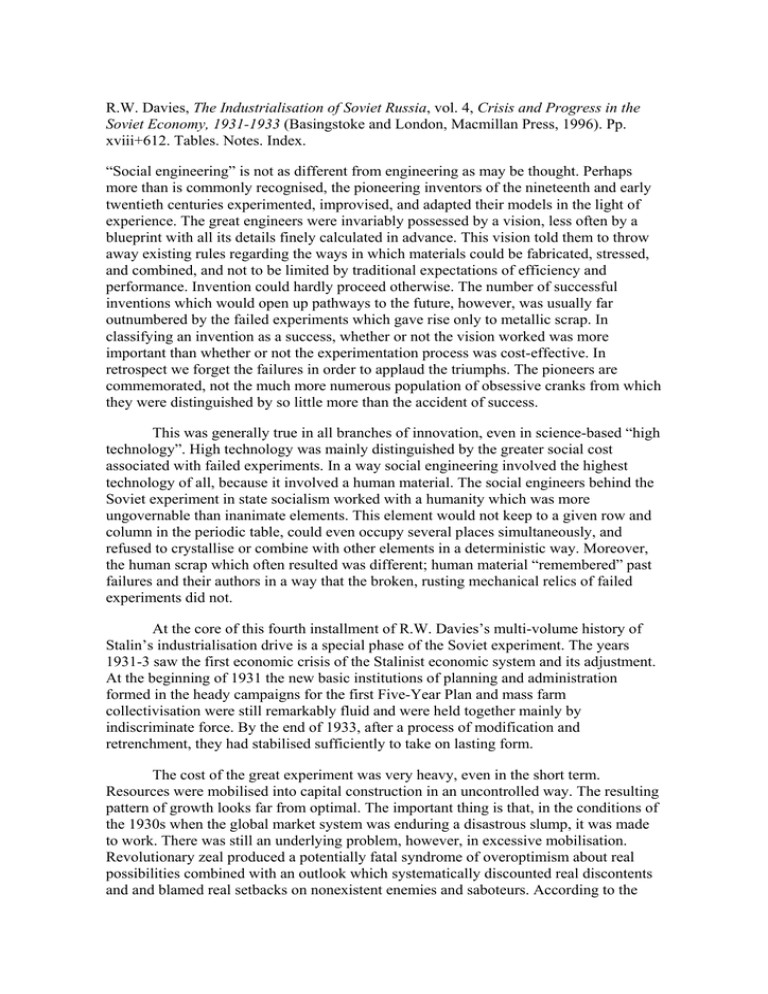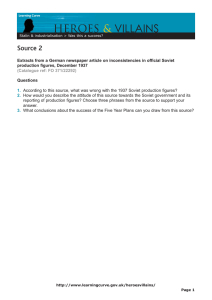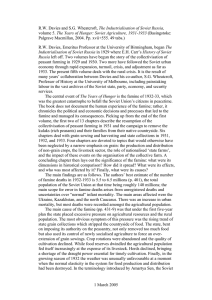The Industrialisation of Soviet Russia xviii+612. Tables. Notes. Index. Soviet Economy, 1931-1933
advertisement

R.W. Davies, The Industrialisation of Soviet Russia, vol. 4, Crisis and Progress in the Soviet Economy, 1931-1933 (Basingstoke and London, Macmillan Press, 1996). Pp. xviii+612. Tables. Notes. Index. “Social engineering” is not as different from engineering as may be thought. Perhaps more than is commonly recognised, the pioneering inventors of the nineteenth and early twentieth centuries experimented, improvised, and adapted their models in the light of experience. The great engineers were invariably possessed by a vision, less often by a blueprint with all its details finely calculated in advance. This vision told them to throw away existing rules regarding the ways in which materials could be fabricated, stressed, and combined, and not to be limited by traditional expectations of efficiency and performance. Invention could hardly proceed otherwise. The number of successful inventions which would open up pathways to the future, however, was usually far outnumbered by the failed experiments which gave rise only to metallic scrap. In classifying an invention as a success, whether or not the vision worked was more important than whether or not the experimentation process was cost-effective. In retrospect we forget the failures in order to applaud the triumphs. The pioneers are commemorated, not the much more numerous population of obsessive cranks from which they were distinguished by so little more than the accident of success. This was generally true in all branches of innovation, even in science-based “high technology”. High technology was mainly distinguished by the greater social cost associated with failed experiments. In a way social engineering involved the highest technology of all, because it involved a human material. The social engineers behind the Soviet experiment in state socialism worked with a humanity which was more ungovernable than inanimate elements. This element would not keep to a given row and column in the periodic table, could even occupy several places simultaneously, and refused to crystallise or combine with other elements in a deterministic way. Moreover, the human scrap which often resulted was different; human material “remembered” past failures and their authors in a way that the broken, rusting mechanical relics of failed experiments did not. At the core of this fourth installment of R.W. Davies’s multi-volume history of Stalin’s industrialisation drive is a special phase of the Soviet experiment. The years 1931-3 saw the first economic crisis of the Stalinist economic system and its adjustment. At the beginning of 1931 the new basic institutions of planning and administration formed in the heady campaigns for the first Five-Year Plan and mass farm collectivisation were still remarkably fluid and were held together mainly by indiscriminate force. By the end of 1933, after a process of modification and retrenchment, they had stabilised sufficiently to take on lasting form. The cost of the great experiment was very heavy, even in the short term. Resources were mobilised into capital construction in an uncontrolled way. The resulting pattern of growth looks far from optimal. The important thing is that, in the conditions of the 1930s when the global market system was enduring a disastrous slump, it was made to work. There was still an underlying problem, however, in excessive mobilisation. Revolutionary zeal produced a potentially fatal syndrome of overoptimism about real possibilities combined with an outlook which systematically discounted real discontents and and blamed real setbacks on nonexistent enemies and saboteurs. According to the 2 previously unpublished text of a famous speech delivered in 1931, Stalin called on the party to “thrash” the “‘wise men’, so-called wise men, who talk to you about realistic plans and so on. We know what these ‘realistic’ plans are ... Reality - that’s you and us! If we want to work in a new way, we shall achieve everything. If we do not want to work in a new way - no ‘realistic’ plans will save us!” (p. 75). But the uncontrolled mobilisation of resources precipitated a general economic crisis, and in the countryside a famine, the subject of Davies’s volume 5 (now in preparation and to be authored jointly with Stephen Wheatcroft), in which millions starved. By the end of 1931 the utopian visions tested out in 1929-30 were already in retreat. First to reemerge were financial controls on industry, wage incentives, individual management responsibility, and the right to buy and sell private food produce on the free market. These had to be accommodated in 1932-3 within a new institutional context, a centralised, administered economy quite different from the past. The restoration of monetary controls and market elements was temporarily speeded up in response to the growing food shortage in the summer of 1932 (however, the gathering famine brought a temporary return to consumer rationing before it was over). As well as modification of institutions, economic stabilisation necessarily involved cutbacks in overambitious quantitative targets; in 1931 the full rigour of the first five-year plan was still being endorsed, but by 1932 a turn to moderation was being marked. This was the way in which elements of a market economy were entrenched within the administrative command system. They came complete with a doctrinal reinterpretation of MarxismLeninism which, as in other episodes of Soviet restructuring, embraced necessities previously rejected as unpalatable and declared them to be enduring features of socialist political economy. The adjustment was therefore ideological as well as economic. Adjustment came too late, however, to prevent catastrophe in the countryside, made inevitable by a collapse of resources which could not be made good by better incentives. Thus the adjustment of the great experiment was complete by the end of 1933, but in the process millions had died. What remained the same through the adjustment process? One constant of the great experiment was the goal of policy, “the most rapid possible development of the capital goods and armaments industries”; policy itself “was enforced in spite of famine in the countryside and hunger in the towns. While in some respects the economic system became more flexible, the dominant trend ... was to strengthen the central levers of power and the repressive apparatus” (p. 457). What does this book add to what is already known? Those familiar with Davies’s previous writings on the interwar Soviet economy will already recognise several of these themes. In the present work they are given an exceptionally deep substructure of documentation built up through meticulous research. To the traditional sources available to western historians of the period (contemporary newspapers, periodicals, and published statistics, speeches and decrees, official and authorised histories and emigre testimony) has been added comprehensive archival documentation of previously secret discussions, intelligence reports, and classified figures. Through Davies’s words they reveal a system in which Stalin and his immediate circle accumulated huge personal power at the centre, but could not use it for long without restraint; there was a wider circle of administrative leaders right down to the management level of key factories to which consultation was soon necessarily extended for the sake of greater realism at the centre and effectiveness of central authority. This wider circle comprised key economic managers who exercised 3 intrinsic discretion in the implementation of centrally determined policy, because policy placed on them impossible burdens which could only be realistically shouldered partly by breaking the rules, partly by ignoring its wildest demands. Even within this wider circle control over the levers of the economy was highly imperfect, with unintended consequences of policy continually forcing themselves onto the management agenda, and was frequently disrupted by workplace campaigns and purges which were the political and social concomitants of resource mobilisation. Would-be readers of The Industrialisation of Soviet Russia may ask whether it was worth Davies’s expending words (perhaps 150,000 a year, if the companion volume on the famine is written on the same scale) at such a rate. The basic premise of these volumes is that history matters: events evolved along a nondeterministic path in which the possibilities available in each moment depended upon the choices made the moment before and in all preceding moments. Thus the detail of the narrative is Davies’s corrective to the relative overabundance of static, ahistorical schemes by which the Stalinist economy is usually categorised. Of these schemes in his final chapter (essential reading for an undergraduate booklist) Davies delineates three, the “command system”, “totalitarianism”, and a “technocratic” hierarchy. Ultimately such schemes, if they are to command our intellectual loyalty, have to survive the test of confrontation with historical documentation of real events, real trends, and real choices. Just as the great enterprises of social engineers can usually override individual protest, and are only closed down by resistance and frictions on a mass scale, the overthrow of deterministic schemes can be accomplished only rarely by the counterexample of individual anecdote. What is really needed is the hard work and patient accumulation of conflicting detail. Exemplified in the present work, the latter shows the evolution of the Soviet economy in these crucial years as vision interacting with reality, power with resistance, action with reaction at every stage. Precise evaluations of the great experiment will probably always differ, but this is a noble account to which all will turn for enlightenment. MARK HARRISON University of Warwick






